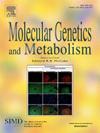巴西南部典型半乳糖血症的临床和遗传特征
IF 3.5
2区 生物学
Q2 ENDOCRINOLOGY & METABOLISM
引用次数: 0
摘要
经典半乳糖血症(CG)是一种罕见的代谢性疾病,可导致新生儿急性肝功能障碍,经饮食治疗后显著改善。然而,长期的并发症,如智力缺陷,往往持续存在。目的描述巴西南部一组患者CG的人口学、临床和遗传特征。方法通过对巴西南格兰德州里约热内卢市随访的CG患者的病历回顾来检索资料。结果纳入31例患者(家庭29例;种族:白人= 20人,土著开冈人= 9人,黑人= 2人;女性= 14)。5名患者通过私人NBS诊断并在中位年龄17天(15-30)时开始治疗,而其他患者在5天(1-19)时出现症状,在27天(5 - 4680)开始治疗。8例患者表现为脑瘫、小头畸形和/或癫痫,2例死亡。临床表现为脑MRI“双帽征”(n = 1),假性高血糖(n = 3),壳三酸苷酶活性升高(n = 3)。在25/31例患者中进行了GALT测序,发现最常见的因果变异是c.563一个比;G (p.Gln188Arg)。检测到两种新的变体:c.164G >;T (p.Gly55Val),与临床变异性半乳糖血症相关;一个新的单倍型c [90dup;529 A >;G] (p.[His31Alafs*9;Met177Val])。据估计,该土著人口中CG的最低流行率至少为1:900活产。结论该数据改善了有症状诊断患者的CG特征,并确定了开港人群中由于奠基人效应而导致的CG高发。本文章由计算机程序翻译,如有差异,请以英文原文为准。
Clinical and genetic features of Classic Galactosemia in the south of Brazil
Introduction
Classic Galactosemia (CG) is a rare metabolic disorder that leads to acute neonatal hepatic dysfunction, with striking improvement after diet treatment. However, long-term complications, such as intellectual deficits, often persist.
Aim
To describe the demographic, clinical, and genetic features of CG in a cohort of patients from South Brazil.
Methods
Data were retrieved through medical charts review of CG patients followed in Rio Grande do Sul, Brazil.
Results
Thirty-one patients were included (families = 29; ethnicity: white = 20, indigenous Kaingang = 9, black = 2; female = 14). Five patients were diagnosed through private NBS and began treatment at a median age of 17 days (15–30), while others presented symptoms at 5 days (1–19) starting treatment at 27 days (5–4680). Eight patients presented Cerebral Palsy, Microcephaly, and/or Epilepsy, and two had died. Notable clinical findings were the “double cap sign” in Brain MRI (n = 1), pseudohyperglycemia (n = 3), and elevated chitotriosidase activity (n = 3). GALT sequencing was performed in 25/31 patients, and the most frequent causal variant found was c.563 A > G (p.Gln188Arg). Two novel variants were detected: c.164G > T (p.Gly55Val), associated with clinical variant galactosemia; and a novel haplotype c.[90dup; 529 A > G] (p.[His31Alafs*9;Met177Val]) detected in Kaingang patients. The minimal prevalence of CG in this Indigenous population was estimated in at least 1:900 live births.
Conclusion
This data improves the characterization of CG in symptomatic diagnosed patients and identifies a high incidence of CG in the Kaingang people due to a founder effect.
求助全文
通过发布文献求助,成功后即可免费获取论文全文。
去求助
来源期刊

Molecular genetics and metabolism
生物-生化与分子生物学
CiteScore
5.90
自引率
7.90%
发文量
621
审稿时长
34 days
期刊介绍:
Molecular Genetics and Metabolism contributes to the understanding of the metabolic and molecular basis of disease. This peer reviewed journal publishes articles describing investigations that use the tools of biochemical genetics and molecular genetics for studies of normal and disease states in humans and animal models.
 求助内容:
求助内容: 应助结果提醒方式:
应助结果提醒方式:


